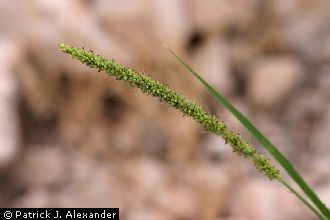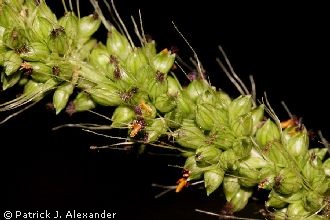Chaetochloa leucopila Scribn. & Merr.
Scientific Name: Chaetochloa leucopila Scribn. & Merr.

| General Information | |
|---|---|
| Usda Symbol | CHLE9 |
| Group | Monocot |
| Life Cycle | Perennial |
| Growth Habits | Graminoid |
| Native Locations | CHLE9 |
Plant Guide
Alternate Names
Setaria macrostachya Kunth in H,B,K, Setaria vulpiseta (plains bristlegrass), Setaria texana (Texas bristlegrass) and Setaria leucopila are all sometimes included under the common name of plains bristlegrass, It is suspected that all three species, along with S, scheelei, may hybridize, (When ordering bristlegrass seed, it should be realized that the seed may belong to any of these three species, Much of the seed industry still uses the common name plains bristlegrass to include Setaria macrostachya, S, Use soil moisture sensors to measure the soil moisture of Chaetochloa leucopila Scribn. & Merr.., vulpiseta, S, leucopila, and S, texana, However, there are notable ecological and morphological differences between the three species which may affect the suitability of the plants for a specific site or project),
Uses
Streambed bristlegrass provides fair to good forage for livestock and wildlife. It is a good seed producer, and its seeds can provide a source of food for upland-bird habitats (Hatch, Schuster and Drawe, 1999). It is also useful for highway right-of-ways and ecosystem restoration.
Status
Please consult the PLANTS Web site and your State Department of Natural Resources for this plant’s current status (e.g. threatened or endangered species, state noxious status and wetland indicator values).
Description
General: Streambed bristlegrass is a native, warm season, perennial bunchgrass which turns a pale whitish color at maturity. It has stiffly erect stems and can grow up to three feet in height. Leaf blades are flat, 3 to 10 inches long and typically less than ¼ inch wide. Sheaths have long hairs along the upper margins. Plants produce a densely flowered, contracted seedhead that is generally 2-4 inches long and only about a ¼ inch thick. The bristles, by which it gets its common name, are 4 to 15 mm long and are usually solitary below each spikelet. Spikelets are from 2.1-2.7 millimeters (Gould, 1975). Distribution: For current distribution, please consult the Plant Profile page for this species on the PLANTS Web site. It is found mainly in Texas, New Mexico and Arizona. It also can be encountered in Colorado, Oklahoma, Arkansas and Florida. Habitat: Streambed bristlegrass is generally found in the dry rangelands of Texas to Arizona with annual rainfall of 10 to 26 inches. In the west it occurs at elevations of 3,000 to 7,000 feet (Gay and Dwyer, 1980). It is located on bottomlands and alluvial flats as well as well-drained, dry, open sites. However, it predominates on loamy bottomland, clay flat, and saline clay range sites. It is associated with false Rhodes grass, pink pappusgrass, and Arizona cottontop.
Adaptation
Streambed bristlegrass is found on open dry ground, in dry woods, and on well drained, sandy loam soils. In Texas it most often is found on clay to clay loam soils.
Establishment
Seedbed preparation should begin well in advance of planting. Planting can be scheduled for early spring or where there are few cool-season weeds, streambed bristlegrass can be planted in the fall. In Arizona and New Mexico planting should be timed to catch the summer monsoons. Establish a clean, weed-free seedbed by either tillage or herbicides. Prior to planting, the site should be firm and have accumulated soil moisture. Streambed bristlegrass is best seeded using a grass drill to ensure a good planting of the small seed. Broadcast seeding may be used in areas not easily planted with a drill, but some type of additional coverage such as culti-packing or light dragging will be beneficial to ensure good seed to soil contact. Seed should be planted 1/8 to 1/4 inch deep. It is better to plant too shallow than too deep. For calibration purposes, Kika819 Germplasm streambed bristlegrass contains approximately 370,000 seeds per bulk pound. A seeding rate of 2 pound of pure live seed (PLS) per acre is recommended. In planting mixtures reduce the rate according to the percent of streambed bristlegrass in the mixture. Soil analysis should be performed prior to planting to determine the necessary levels of nitrogen, phosphorus and potassium. Nitrogen should not be applied until the stand is established. If one plant per square foot has become established than the planting has been successful.
Management
Streambed bristlegrass should not be grazed the first year. After a stand is established, either continuous or rotational grazing can be used. Contact your local NRCS field office for assistance in developing a prescribed grazing plan. Plants should be allowed to produce seed occasionally to insure stand health. Streambed bristlegrass is a long-lived perennial that is extremely drought and fire tolerant once established.
Pests and Potential Problems
Control of pests may be necessary in order to produce seed crops in dry years under irrigation.
Seeds and Plant Production
Plant Production
Plant Production
Seed increase plots have been planted on 36” bedded rows, however flat plantings may be possible with frequent weeding. Streambed bristlegrass can also be established with vegetative transplants. This is an especially effective method when dealing with a highly dormant accession of streambed bristlegrass. Rapid growth of transplants can be expected providing seed harvests within the first year. Furthermore transplants stands facilitate better weed control in the seed production fields. Deep soil tillage or frequent close cultivation is recommended to promote seed production. Commercial herbicides are available for weed control once plants are beyond the seedling growth stage. Consult your local extension weed specialist for recommended herbicides. Streambed bristlegrass produces seed throughout the year. Seed is harvested with a combine. The use of slow travel and RPM speeds (<5mph) while harvesting results in relatively clean seed, needing little cleaning or processing. A clipper seed cleaner is used to clean stems and chaff. Seed fields have ranged in yields from 100 to 500 bulk pounds of clean seed. Purity of the seed is usually around 90%. However, this species tends to have a very high dormancy factor ranging from 90-99%. Therefore, 28 day germination rates can vary from 40 to 1%. Adequately stored seed in humidity and temperature controlled facilities can be expected to stay viable for over 10 years. Cultivars, Improved, and Selected Materials (and area of origin) Catarina blend bristlegrass is a commercial blend of four bristlegrass collections from south Texas. One component is a plains bristlegrass (Setaria vulpiseta ) collected in Webb County, Texas. The other three components are streambed bristlegrass (Setaria leucopila) collected in Karnes, Bexar and Willacy Counties. Catarina blend bristlegrass was released by the E. “Kika” de la Garza Plant Materials Center in 2006. This collection was chosen because of its excellent germination rates of 40% along with its long-term seed dormancy for droughty conditions. It is adaptable to a wide range of soil types. It also produces an abundance of seed for upland game birds and a fair amount of forage for livestock and wildlife. Breeder seed is maintained by USDA-NRCS E.”Kika” de la Garza Plant Materials Center, Kingsville, Texas in conjunction with Texas Foundation Seed Service. ‘Stevan’ plains bristlegrass (Setaria leucopila) was released in 1994 by the USDA-NRCS (formerly the Soil Conservation Service (SCS)) and the University of Arizona Agricultural Experiment Station for use in Arizona, New Mexico and western Texas. ‘Stevan’ bristlegrass is a population of 13 accessions that were selected by the Tucson Plant Materials Center. ‘Stevan’ exhibited significantly higher seedling emergence than commercially available populations of other bristlegrasses. It was selected primarily for use in revegetation of eroded rangelands, retired croplands, critical areas and to provide forage for wildlife and livestock. Breeder seed is maintained by USDA-NRCS Tucson Plant Materials Center, Tucson, Arizona.
References
Gay, Jr., C.W. and D.D. Dwyer. 1980. New Mexico Range Plants. New Mexico State University Cooperative Extension Service Circular 374. Las Cruces, NM. Gould, F.W. 1975. The Grasses of Texas. Texas A&M University Press. College Station, TX. Hatch, S. L. , J.L. Schuster and D. L. Drawe. 1999. Grasses of the Texas Gulf Prairies and Marshes. Texas A&M University Press. College Station, TX.
Prepared By
John Lloyd-Reilley, Manager USDA-NRCS E. “Kika” de la Garza Plant Materials Center, Kingsville, Texas Citation Lloyd-Reilley, J. 2010. Plant guide for streambed bristlegrass (Setaria leucopila). USDA-Natural Resources Conservation Service, E. “Kika” de la Garza Plant Materials Center. Kingsville, TX. Published October, 2010 Edited: [15Sep2010 sdm] For more information about this and other plants, please contact your local NRCS field office or

